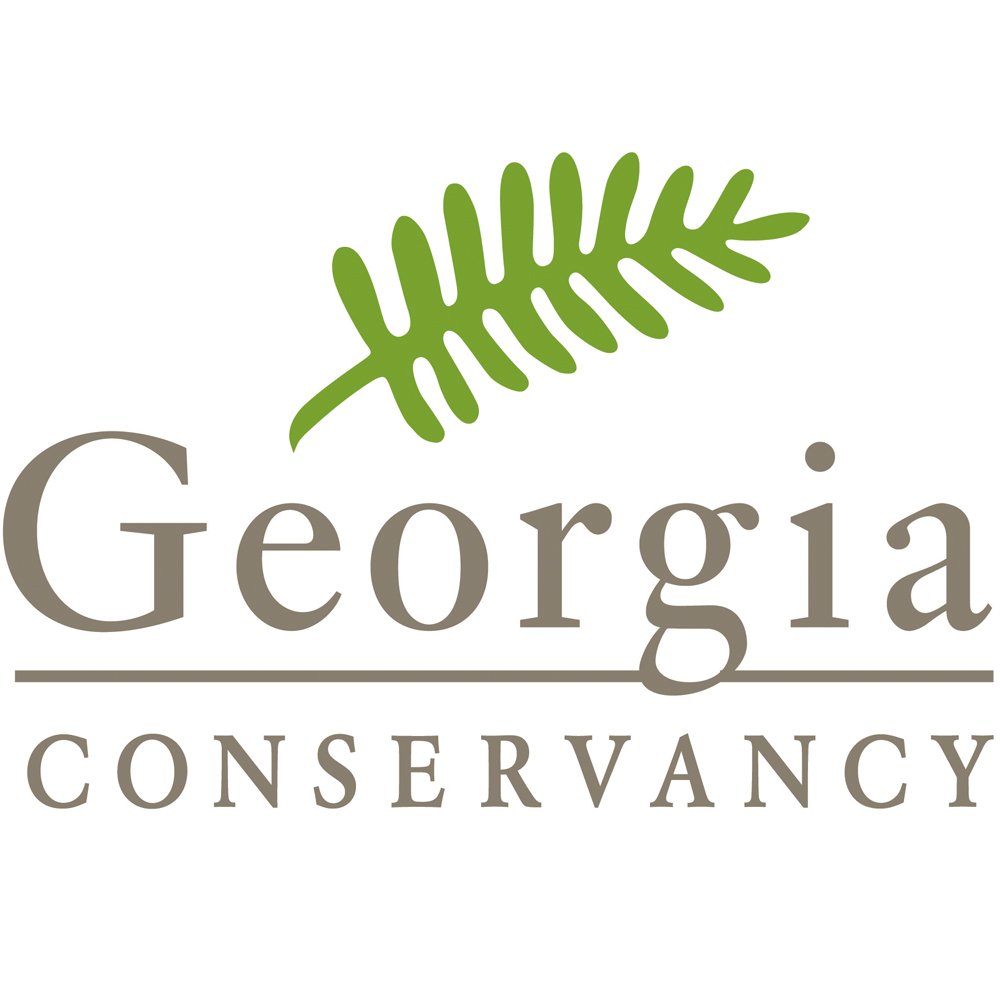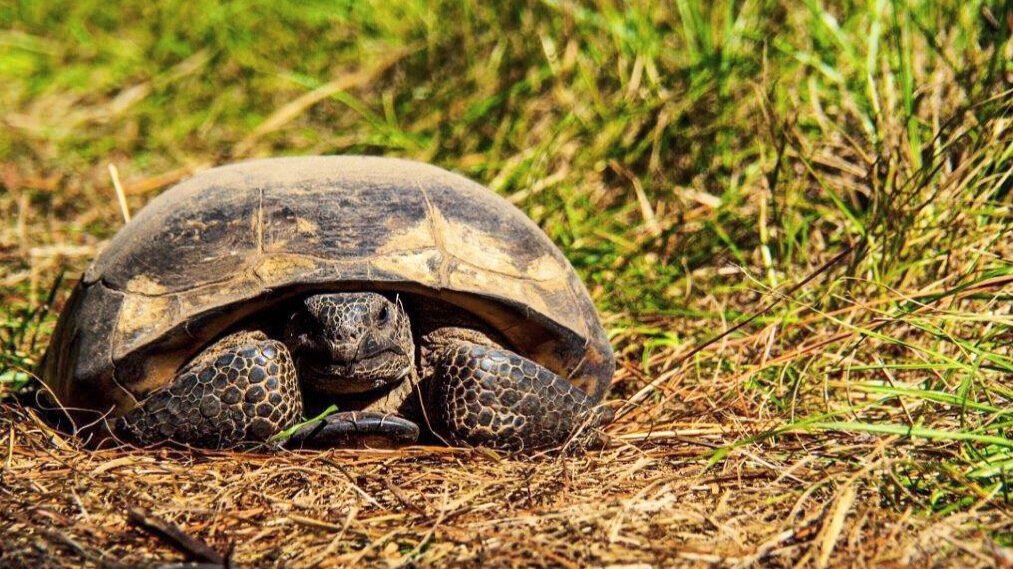Questions regarding a gopher tortoise population on your property? Please contact Georgia Department of Natural Resources at 706-557-3213
The Georgia Gopher Tortoise Conservation Initiative
Conserving habit critical for the protection of the gopher tortoise, Georgia’s state reptile and threatened keystone species.
October 2022 Update: For years, conserving the Longleaf Pine Ecosystem has been a high conservation priority in Georgia. Fueled by the need to accelerate this work to benefit one of this ecosystem’s keystone species, the gopher tortoise, and aided by an uncommon level of site specific knowledge, the Gopher Tortoise Conservation Initiative has sought to permanently protect a minimum of 100,000 acres of gopher tortoise habitat in Georgia. These efforts have benefited other species that depend on longleaf habitat, including the striped newt, indigo snake, flatwoods salamander, gopher frog, southern hognose snake, and eastern diamond‐backed rattlesnake. Our success has resulted in the establishment of new public recreation areas for hunting, fishing, hiking and other outdoor activities.
Importantly, these years of efforts have precluded the need of the federal government to list the gopher tortoise as endangered under the Endangered Species Act - providing assurances for a more compatible economic environment for Georgia’s business community.
The eastern population of the gopher tortoise remains a threatened species at the state level.
ABOUT THE GEORGIA GOPHER TORTOISE CONSERVATION INITIATIVE
Established in 2017, the Georgia Gopher Tortoise Conservation Initiative is a collaborative effort between Georgia Department of Natural Resrouces, the Georgia Forestry Commission, Georgia Chamber of Commerce, U.S. Department of Defense, The Knobloch Family Foundation, The Conservation Fund, The Georgia Conservancy, The Nature Conservancy, The Orianne Society, Wild Ark, and the U.S. Fish and Wildlife Service.
The Opportunity
Within the Southeast, we have been at the proverbial fork in the road when it comes to protecting the gopher tortoise. One route, taking no action, could lead to a federal listing of the species, which could have a negative impact in the region due to increased federal oversight of many sectors of the Georgia economy, including commercial growth, agriculture, the timber industry, and activities on military bases. The other route, investing in land to protect gopher tortoise habitat that in some cases will provide public recreation land, requires creativity and action with the anticipated result of conserving a flagship species and its endangered and iconic habitat and avoiding a federal listing. If we are not proactive and the gopher tortoise is listed, people may ask why we didn’t take action when we had time to do so. It is far more expensive to correct a problem than to take steps to avoid one. And, rarely do we have such an opportunity to accomplish collaborative conservation results at this scale.
Based on field work to identify properties with viable populations of gopher tortoises, Georgia DNR and partners established a goal for the Gopher Tortoise Conservation Initiative to preserve a minimum of 100,000 acres of land. The belief is this would preclude the need to list the gopher tortoise and numerous other species while also protecting our water sources, important conservation areas and providing additional public recreation lands. Considering this would be achieved through fee simple purchases and conservation easements, because we recognize not all landowners will sell their properties, the cost to protect this land was projected to hit $150M.
Courtesy of Georgia DNR (Click to Enlarge)
Status of Gopher Tortoise Populations
The Georgia Department of Natural Resources (DNR) and partners have actively surveyed gopher tortoise populations throughout Georgia, allowing GCTCI to create a prioritization list informed by the best available science. A minimum viable population is considered to be 250 adult tortoises. There are about 122 viable populations in the state, of which 62 (Fall 2022) are now permanently protected, up from 38 populations in 2017. A minimum goal to avoid a listing was to permanently protect 65 of the 122 viable populations through a combination of fee simple acquisitions and conservation easements. Efforts to protect additional populations are ongoing and will continue. Georgia DNR believes these actions would protect enough habitat to preclude the need to list the gopher tortoise as well as the multiple other species being considered for federal listing that depend on this habitat type.
Georgia DNR and the U.S. Fish and Wildlife Service (USFWS) have developed a draft map (right) that subdivides South Georgia into regions and indicates how many gopher tortoise populations are currently protected in each region and how many more need to be protected to avoid a federal listing. This map and the gopher tortoise survey data will drive this project.
This campaign is geared to protecting and managing enough gopher tortoise habitat to preclude a listing. The partners working on this effort realize that protection of the land is not enough to ensure the gopher tortoise and multiple other at‐risk species found in this community are sustainable. Restoration and long‐ term management of these lands will be critical.
From Georgia Department of Natural Resources: Matt Elliott, an assistant chief with DNR’s Wildlife Conservation Section who helped create the Gopher Tortoise Conservation Initiative, said the determination to not list tortoises in the eastern part of their range doesn’t mean the work is done. The species still faces major threats, including habitat loss. Elliott noted that the Fish and Wildlife Service also stressed the need for continued protection in states.
“It’s still going to be a high-priority species in Georgia’s State Wildlife Action Plan and remain on the state-protected species list,” he said. “We’re going to continue to work with landowners for gopher tortoises. We’re going to continue managing for them on state property.”
Key Challenges of the Gopher Tortoise Conservation Initiative
Ability to move quickly, critical conservation lands are being lost at an alarming rate;
Continued State funding for acquisition of new public lands and conservation easements over targeted private lands;
Private funding for new public lands and conservation easements on private lands;
Funding for management and restoration of newly acquired gopher tortoise conservation lands;
Working with industry, agriculture, mining and solar partners early in their site location process to avoid key habitat.
ABOUT THE GOPHER TORTOISE
The gopher tortoise is Georgia’s state reptile and is a listed as a threatened species by Georgia state and Federal law. Gopher tortoise habitats range from the Atlantic Coastal Plain of extreme southern South Carolina we along the Gulf of Mexico’s coastal plains to extreme eastern Louisiana and peninsular Florida. It inhabits areas of well-drained, deep sandy soils, and open-canopied forests.
Due to habitat loss and disturbance, this species had declined to the point where is is now dispersed in isolated populations within its range.
The gopher tortoise, a keystone species, provides habitat for more than 358 species in its burrows. Its inquilines (co-inhabitants) include the dung beetle, which converts dung into soil nutrients, the indigo snake, and the gopher frog, which is found nowhere else.
Gopher tortoises average in size from 5 to 12 inches and its carapace, or upper shell, varies from dark brown to grayish black. The plastron under its shell is yellowish and the exposed skin of the head, neck and legs is greyish black.
April 2020 GTCI Update
If you have any questions regarding the Georgia Gopher Tortoise Initiative, please contact Georgia Conservancy Communications Director Brian Foster at bfoster@gaconservancy.org






